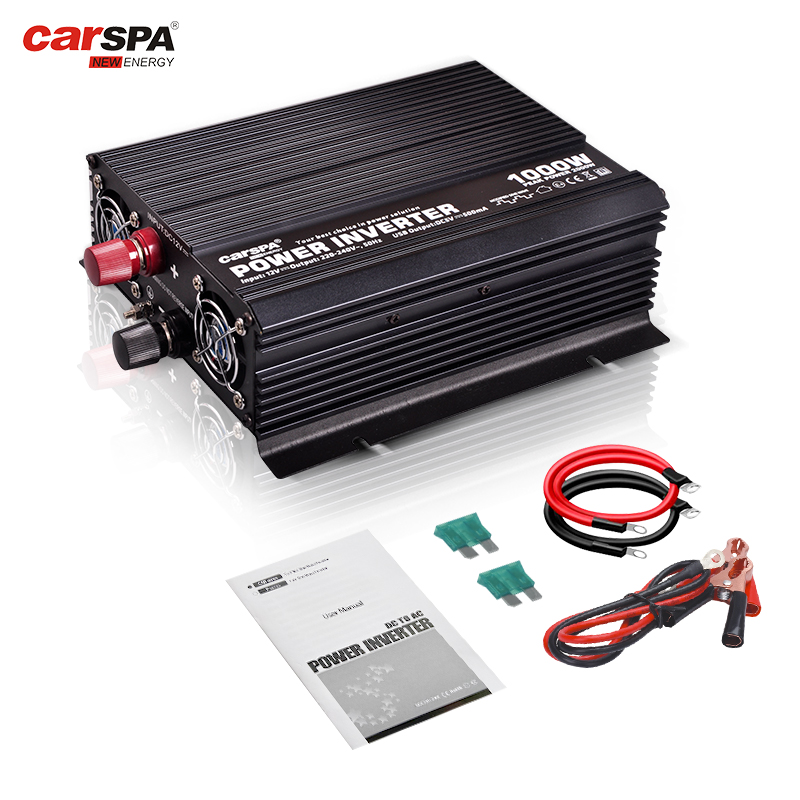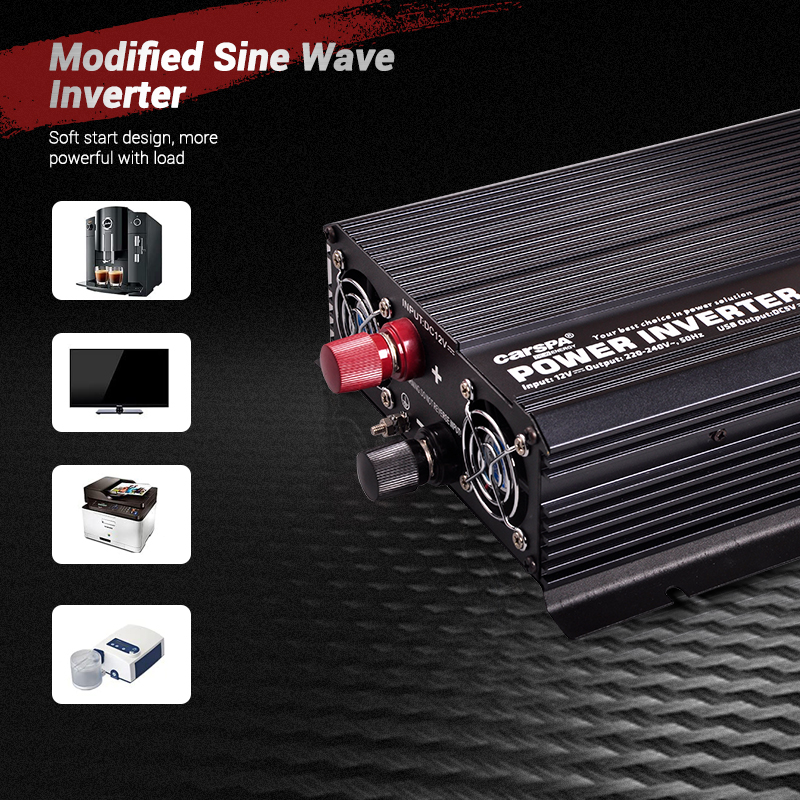Can a 12-volt 75Ah battery run a 1000 watts inverter?
In solar systems, car power supplies, and emergency power systems, the combination of 12V batteries and 1000W inverters is common. However, can a 12V battery with a capacity of 75Ah drive a 1000W inverter and how long can it last? This article will answer this question in detail through specific calculations and analysis to help you better understand how to match batteries and inverters.
How much power does a 1000W inverter require?
First, we need to understand the power requirements of a 1000W inverter. A 1000W inverter means that it has an output power of 1000 watts, but in order to maintain this output power, it needs to get enough current from the battery. For the inverter, the required current can be calculated by the relationship between power and voltage.
Calculation of current requirements
The input power requirements of a 1000-watt inverter can be calculated using the following formula:
Current (Amps) = Inverter Power (Watts) / Battery Voltage (Volts)
Substituting the data into the formula:
Current = 1000/12≈83.3 Amps
This means that the power inverter needs to draw about 83.3 Amps from the battery when fully loaded. It should be noted that the battery will discharge quickly when providing such high current to the inverter, and the depth of discharge will have an impact on the sustainable power supply time and life of the battery.
Consider the efficiency of the inverter
The inverter will have some power losses when converting direct current (DC) to alternating current (AC), and its efficiency is generally between 85% and 90%. Assuming the inverter is 90% efficient, the required input power will be:
Input power = 1000/0.9≈1111 watts
Therefore, the actual current requirement is:
Current = 1111/12≈92.6 amps
It can be seen that the 1000-watt inverter requires a current supply of about 92.6 amps when running at full load, and the 75Ah battery may not be able to maintain this current demand for a long time.
How long can a 75Ah battery support the operation of a 1000-watt inverter?
Next, we can calculate the actual power supply time of a 12-volt 75Ah battery by the battery capacity and the current demand of the inverter. Battery capacity is usually measured in ampere-hours (Ah), which indicates the time the battery can supply power at a certain current. In this case, the battery capacity is 75Ah.
Calculation of power supply time
The power supply time can be calculated by the following formula:
Power supply time (hours) = battery capacity (Ah) / inverter current demand (A)
Substitute the data for calculation:
Power supply time = 75/92.6≈0.81 hours
That is, in theory, a 12V 75Ah battery can support a 1000W inverter for about 0.8 hours, or about 48 minutes. This does not take into account the impact of battery discharge depth on battery life.
Impact of discharge depth
For common battery types such as lead-acid batteries, deep discharge will seriously affect battery life. It is usually recommended that the discharge depth should not exceed 50%, which means that we can only use about 37.5Ah of power. In this case, the power supply time will be halved:
Power supply time = 37.5/92.6≈0.4 hours
That is, in order to protect the battery life, in the case of shallow discharge, this battery can only support a 1000W inverter for about 24 minutes. Therefore, if you want the battery to be used for a long time, the 75Ah battery is not an ideal choice.
Is a 75Ah battery suitable for driving a 1000W inverter? What are some better options?
From the above calculations, we can see that a 12V 75Ah battery can only drive a 1000W inverter for a short time, and if a longer power supply time is required, a 75Ah battery may not be suitable. Here are some better options and solutions to achieve a longer stable power supply.
Increase battery capacity
If you want to extend the power supply time of a 1000W inverter, you can consider increasing the battery capacity. For example, choosing a 12V 150Ah battery, which has twice the capacity of a 75Ah, will double the power supply time at the same current demand, and can run for about 1.6 hours. In addition, the total capacity can be increased to 150Ah by connecting two 75Ah batteries in parallel.
Use a higher voltage battery system
Increasing the system voltage can also effectively reduce the current demand. For example, using a 24V battery system, the current required by the inverter will be reduced by half to only about 46.3 amps. In this case, using a battery with a higher capacity can reduce the depth of discharge, thereby extending the battery life.
Replace with a deep cycle battery
Deep cycle batteries are able to withstand a greater depth of discharge, so they are very suitable for inverter power supply. Unlike ordinary batteries, deep cycle batteries do not significantly shorten their life even after deep discharge, so if you need to drive a 1000-watt inverter for a long time, you can choose a large-capacity deep cycle battery.
Through these optimization schemes, the power supply needs of the 1000-watt inverter can be better met, and the service life of the battery and inverter can be effectively extended.
How to protect the battery life when running a 1000-watt inverter?
In order to protect the battery life when using a 1000-watt power inverter, some management and protection measures can be taken. The high power demand of the inverter puts a lot of pressure on the battery, so reasonable use and management are essential.
1. Control the depth of discharge
In order to extend the battery life, it is recommended to control the depth of discharge of the battery. Generally speaking, for lead-acid batteries, the depth of discharge should not exceed 50%; while for lithium batteries, the depth of discharge can be appropriately increased, but it is still recommended to avoid full discharge. You can use an inverter with low voltage protection to prevent deep discharge caused by low battery voltage.
2. Regular charging and maintenance
During use, the battery power will continue to consume, and long-term deep discharge will increase battery loss. In order to protect the battery life, it is recommended to charge the battery regularly and keep the battery voltage within a reasonable range. In addition, check the battery wiring and inverter connection to ensure that the equipment is working properly.
3. Use a suitable battery management system (BMS)
If lithium batteries are used, it is recommended to equip a battery management system (BMS) to monitor the battery voltage, current and temperature in real time. This not only provides an alarm when the battery is overcharged or over-discharged, but also effectively controls the charging and discharging process to prevent the battery from being damaged due to excessive use.
4. Reasonable selection of inverter usage scenarios
If only a short period of high-power power supply is required, such as outdoor activities or short-term backup power, a 12V 75Ah battery with a 1000-watt inverter can meet basic needs. However, if long-term power supply is required, it is recommended to choose a battery pack with a larger capacity to avoid frequent battery discharge, which will shorten the life.
Through reasonable battery management and use strategies, the battery life can be effectively protected, making the use of 1000 watt inverters more efficient and safe.
Conclusion
In summary, a 12 volt 75Ah battery can support the operation of a 1000W power inverter for a short time, but the power supply time is short, only about 40 to 50 minutes. In addition, in order to protect the battery life, it is recommended to control the depth of discharge and avoid excessive consumption. For the need to use a 1000 watt inverter for a long time, it is recommended to choose a larger capacity battery pack or use a 24V system to improve efficiency and extend battery life. I hope that the analysis in this article can help you better understand how to match batteries and inverters to meet the power supply needs of different scenarios.






